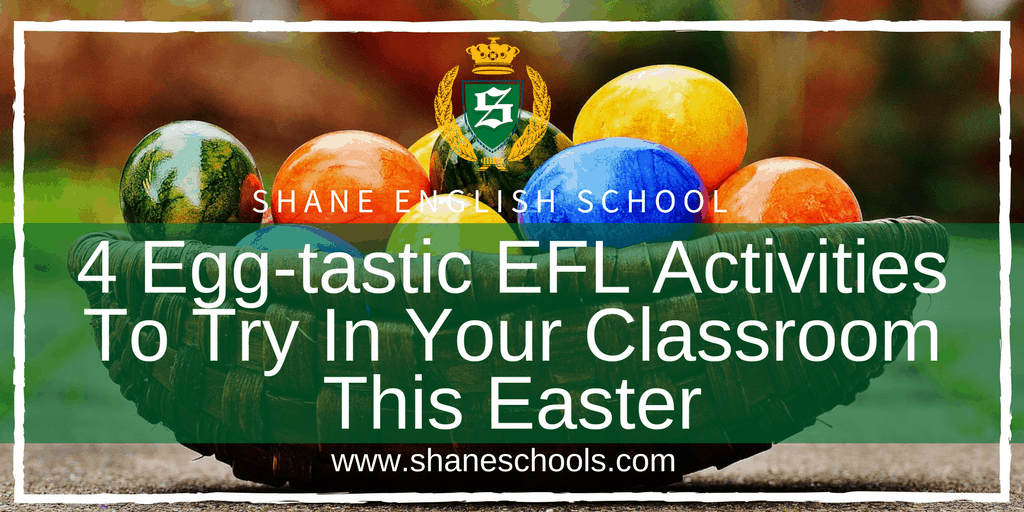Can you believe that Easter is just around the corner? It feels like just yesterday the clock struck twelve on the New Year. Easter is one of the best times to engage your ESL learners with a range of fun and exciting activities while helping them learn more about one of the biggest Western holidays.
While fuelling fun time with chocolates would be a bad idea for classroom management, there are tonnes of fun Easter-themed activities to practice new vocabulary, the four language skills and get your students into the spirit of the holiday.
Here are four of the best egg-tastic EFL activities to try in your classroom this Easter!
1. Easter Egg Faces
Easter Egg Faces is a wonderful EFL activity to test your students listening comprehension skills.
In preparation for the lesson, you will need an egg for each student. Then you can either blow out the insides of the eggs before class or demonstrate to your students how to do this themselves.
At the beginning of the lesson, revise facial feature vocabulary with your class. You can do this with a quick game of Simon Says to get your students engaged and ready for the next part of the lesson.
Once you are satisfied that they know their vocabulary, hand out the eggs and some pens for the students to use. Next, give them step by step instructions on what they have to draw.
For example:
- Draw two eyes
- Draw two eyebrows
- Draw a mouth smiling
- Draw two ears
- Draw a nose
If your class is advanced, you can make this activity a bit harder by adding words like “thick eyebrows”, “long nose” or “big ears” to make the description of the face more exact and less open to interpretation.
2. Easter Dice
If you students are advanced enough to put sentences together, a round of Easter Dice is a perfect themed game to play.
To make your custom dice for your classroom, print out two copies of this dice template and on each side write an Easter related word as well as the usual one to six numbers.
In class, split the class up into two groups. If you have a large class, print out more dice templates and divide the class up into a more manageable number.
Each student will then have an opportunity to roll the dice and have to make up a sentence using the word they rolled. If the student succeeds, their group will get the point equivalent to the number they rolled.
At the end of the game, the group with the highest points wins! And you can even give the winning team some chocolate eggs as their prize.
3. Easter Egg Emotions
Whether you want to revise emotion vocab or introduce the topic, this an egg-tastic activity that your students will love.
In preparation for the lesson, you will need flashcards depicting the range of emotions you want to cover. These can include your basic happy, sad, or angry. For more advanced students you can use harder words like exhausted and excited.
Show each flashcard to the class and elicit the emotion by asking “How is she/he feeling?” You want your students to reply with the structure “She/he is sad.”
If you want to test their vocabulary one more time, you can either play a quick game of “fly swat”, “Charades” or practice spelling with a competitive team spelling bee round.
Once you are ready to continue with the lesson, hand out an egg shell to each student. Next, ask them how they are feeling. Elicit a few answers from the students and make sure they reply with “I am happy” or “I am sleepy.” Afterwards, ask your students to draw how they are feeling onto their egg shells.
Give your students about 10-minutes to complete this task. Once they are done, you can go around and ask them how they are feeling individually, or you can pair students up and get them to practice asking each other.
4. Easter Egg Decoration
What Easter activity list would be complete without everyone’s favourite – Easter egg decoration!
This is a fun activity that your students will love and an excellent opportunity for you to practice a variety of vocab and sentence structures.
For example, you could use this exercise to revise colours. Have your students draw stripes around the egg and assess their listening comprehension by having them decorate individual sections in a particular colour.
Alternatively, if you want something a bit more advanced, you can use the activity to practice the use of present participles. First, revise vocab by making sure your students know the English names for all the decoration tools they will be using as well as the verbs they will need to use.
After a quick revision, you can then ask your students to construct a sentence using the present participle to describe what they are doing. For example, “I am cutting the cardboard” or “I am using the glitter”.
It is an excellent way to let your students get creative in the classroom while still learning at the same time.
There you have it, some of the best Easter-themed games for your ESL classroom! These quick and easy activities will keep your students engaged and thrilled to participate. So you will have no egg-scuse not to have a fun Easter lesson with rich learning possibilities.
About the Author
Lauren Melnick is a South African travel blogger and ESL teacher currently living in Ubon, Thailand. When she isn’t making lesson plans and watching nursery rhymes on YouTube, you can find her eating up a storm, taking selfies with dinosaurs, and planning her next adventure.
Follow her travels on Wanderlust Movement, Facebook, Twitter, and Instagram.

We're hiring!
With schools around the world, Shane English School always has exciting new opportunities to offer.


